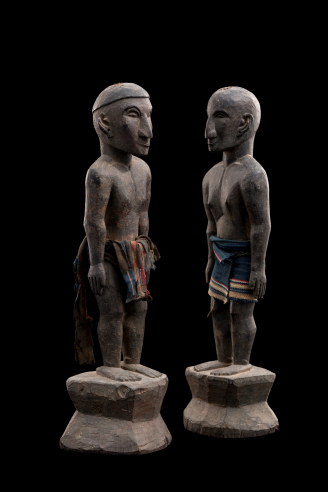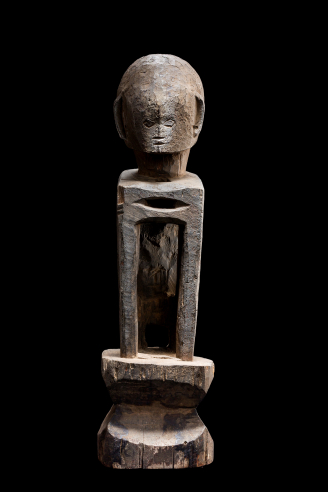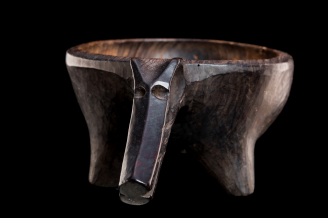Media
Ifugao Sculpture: Expressions in Philippine Cordillera Art
showcasing the powerful simplicity of the rice terraces
30 Nov 2017
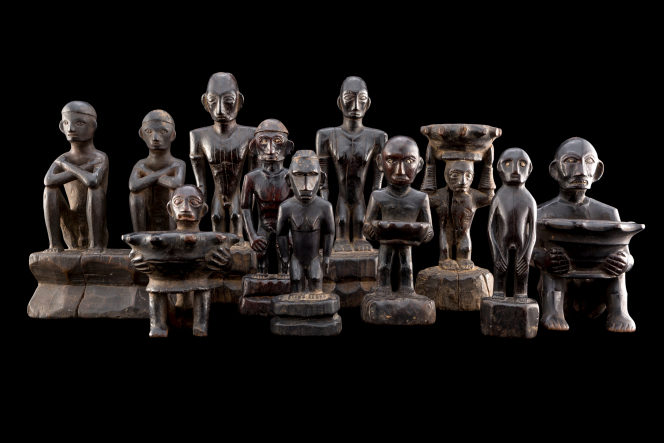
Group of Ten Hipag Figures, Ifugao tribe, Northern Luzon, Philippines
Carved hardwood
H: 15–28.5 cm
Late 19th to early 20th century
The University Museum and Art Gallery (UMAG) of the University of Hong Kong, will present Ifugao Sculpture: Expressions in Philippine Cordillera Art from December 1, 2017 to February 4, 2018, an exhibition of tribal art and culture. Rarely shown in such a large group display, both figurative sculptures and ritual boxes exemplify the talent of artists from the Ifugao, Bontoc and Kankanaey tribes in the northern Luzon region of the Philippines. The exhibition is organised in cooperation with collector Mr Martin Kurer and the Hong Kong-based Asian Art:Future (AA:F), a foundation that specialise in collecting contemporary and antique Asian art.
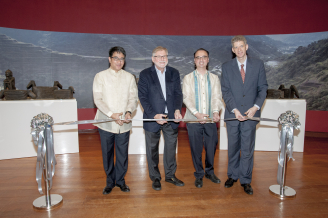
(From left) Ribbon-cutting ceremony by Deputy Consul General of Consulate General of the Philippines in Hong Kong Roderico C Atienza, Chairman of Asian Art:Future Martin Kurer, Secretary of Foreign Affairs of the Republic of the Philippines Sec Alan Peter Cayetano and UMAG Director Florian Knothe.
An opening ceremony of the exhibition was held at UMAG today (November 30). Officiating guests included Secretary of Foreign Affairs of the Republic of the Philippines Sec Alan Peter Cayetano, Acting Consul General of Consulate General of the Philippines in Hong Kong Roderico C Atienza, Chairman of Asian Art:Future Martin Kurer and UMAG Director Florian Knothe.
The works displayed in the show range from sculptural objects, including ‘bulul’ statues, deities associated with the production of bountiful harvests; ‘hipag’ (or ‘hapag’) figures, war deities used as vehicles through which divine help can be summoned; sculptural boxes used in ceremonies, the ‘punamhan’; and various boxes for the storage of food—sometimes called ‘tangongo’ or ‘tanoh’—along with other functional items such as ‘kinahu’, food bowls, and toys.
Fascinated with the modern abstract style of these carved 19th- and 20th-century sculptures, the exhibition takes an artistic rather than an anthropological approach, highlighting the aesthetics of the displayed artworks rather than signifying them as ethnic markers or religious tools. For instance, both the bulul figures and boxes are deeply connected to cultural rituals, while they present abstract expressions of a group of talented rural artists.
Together, these selected pieces showcase the aesthetic and artistic side of a wide range of Cordillera sculptural art from the 18th through the 20th centuries. The pieces are arranged in line with various centres of artistic gravity—‘archaic’, ‘minimalist’, ‘transition’—although the lines are sometimes blurred, and most of the ‘archaic’ material also shows ‘minimalist’ elements.
One of the essays in the exhibition catalogue draws comparisons with other tribal arts and describes their influence over modern Western artists, such as the Russian Wassily Kandinsky (1866–1944), the Romanian Constantin Brancusi (1876–1957) and the French artist George Braque (1882–1963). This claim is based on visual comparisons and it is each object’s physical structure, design value and international character that is highlighted in the current exhibition.
For more images and captions of the exhibits, please click here.
Details of the Exhibition
Period: December 1, 2017 (Friday) to February 4, 2018 (Sunday)
Opening Hours:
09:30 – 18:00 (Monday to Saturday)
13:00 – 18:00 (Sunday)
Closed on University and Public Holidays
Venue: 1/F Fung Ping Shan Building, UMAG, HKU, 90 Bonham Road, Pokfulam
Tel/Email: (852) 2241 5500 (General Enquiry) / museum@hku.hk
Admission: Free
Website: http://www.umag.hku.hk/en/
Connect with UMAG on social media:
Facebook: https://www.facebook.com/umag.hku
Twitter: https://twitter.com/UMAG_HKU
Instagram: #IfugaoSculpture, #PhilippineCordilleraArt, #UMAG
Weibo: @香港大學美術博物館UMAG
About University Museum and Art Gallery of the University of Hong Kong (UMAG)
UMAG was founded in 1953 as the Fung Ping Shan Museum. It was originally established as the Fung Ping Shan Library in 1932 in honour of its benefactor. For more information on UMAG, please click here.
Media enquiries
UMAG Programme Assistant Miss Chelsea Choi, Tel: (852) 2241 5509, Email: cchelsea@hku.hk.
Pair of Standing Bululs, Ifugao tribe, Kababuyan village, Northern Luzon, Philippines
Carved hardwood
H: 44 cm
ca. 1900

